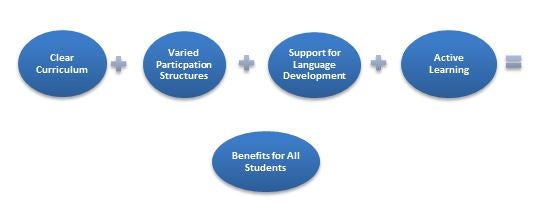“Inclusiveness denies every substance of discrimination. The mark of an inclusive society is one in which people are open, accepting, and supportive of all other persons, enabling them to participate fully in life, the community, and the world.”
Student Equity Center
Our aim in higher education is to make inclusiveness a real possibility in the classroom. In conjunction with inclusive teaching methods, oftentimes a variety of terminology is used to help define points of systemic disadvantage.
So what might inclusiveness mean for higher education? According to the Association of American Colleges and Universities, inclusiveness in higher education strives to promote:
“The active, intentional, and ongoing engagement with diversity – in the curriculum, in the co-curriculum, and in communities (intellectual, social, cultural, geographical) with which individuals might connect – in ways that increase awareness, content knowledge, cognitive sophistication, and empathetic understanding of the complex ways individuals interact within systems and institutions.”
Association of American Colleges and Universities
Why Inclusive Teaching Matters
Inclusive teaching serves our student population better. Not only does it help to make quality education accessible to our multilingual student population, it helps many other students at intersections of disadvantage. Furthermore, linguistically inclusive teaching helps faculty develop into better educators, as many of the changes made to the teaching practice benefit many students. You can learn more about how being inclusive will improve your overall teaching practice by reading “What I Learned From My International Students” from The Chronicle.
To learn more about how inclusive teaching works, visit the National Center on Universal Design for Learning. Their short video, UDL At A Glance, explains the purpose behind inclusive teaching and how it serves to benefit all students.
Getting Started With Inclusive Teaching
Of course, building an inclusive course can be a challenging. But you are not alone! The Center for Teaching and Learning offers workshops on both inclusive teaching and universal design (a closely related concept) which are helpful for starting the process of growing your teaching practice. View current Center for Teaching and Learning workshops.
Additional Resources for Inclusive Teaching
- Bean, John. Engaging Ideas. San Francisco: Jossey-Bass, 2011. Print.
- Losey, Kay, & Shuck, Gail. Plurilingual Pedagogies for Multilingual Writing Classrooms: Engaging the Rich, Communicative Repertoires of U.S. Students. New York and London: Routledge Press, 2022.
- Shapiro, S., Farrelly, R. & Tomas, Z. Fostering International Student Success in Higher Education Virginia. TESOL Press, 2014. Print.
- Universal Design for Learning – A podcast episode by Teaching in Higher Ed.
- Thomas, Cornell. Inclusive Teaching: Presence in the Classroom. San Francisco: Jossey-Bass, 2014. Print.
